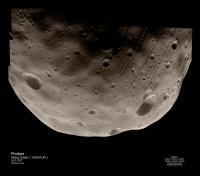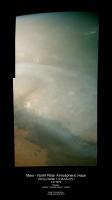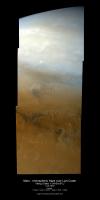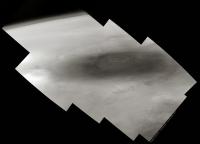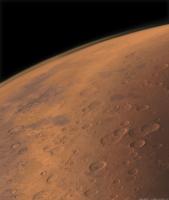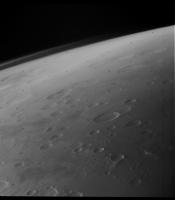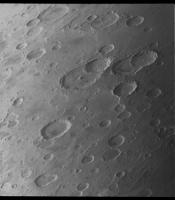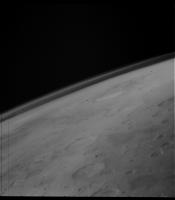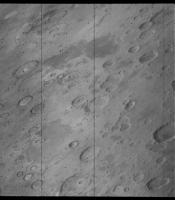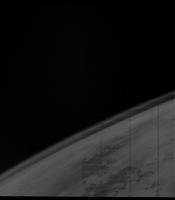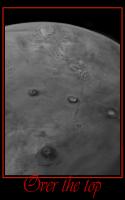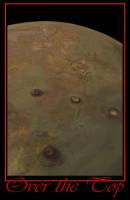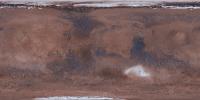Printable Version of Topic
Click here to view this topic in its original format
Unmanned Spaceflight.com _ Past and Future _ Images from Viking Orbiters
Posted by: machi Dec 6 2010, 08:16 AM
"Storm and Shadow"
Phobos shadow passing over dust storm in area of Viking 1 Lander landing site.
Artificially colourised animation made from 20 frames taken by Viking 1 Orbiter.
Timewarp 40×.
Posted by: nprev Dec 6 2010, 08:38 AM
![]() ....whoa!!!
....whoa!!!
Nice. Thanks, Machi!
Posted by: Stu Dec 6 2010, 09:15 AM
Machi, I honestly think it's time you actually came clean and admitted you're a Time Lord, with a TARDIS, and you spend your days zipping back and forth in time, scooting across the solar system from planet to planet, photographing and filming these amazing sights and events you show us...! ![]()
Beautiful stuff, thanks.
Posted by: ZLD Dec 6 2010, 09:42 AM
WOW! Outstanding! I really like this one machi. It really gives me a sense of what it would be like in orbit around Mars. Maybe one day ![]()
Posted by: machi Dec 6 2010, 08:08 PM
Thanks!
Second version with timewarp 10×. Thus, animation is longer, but now it's more difficult to see slow dust storm movement over martian terrain.
Date: 1977-09-28
Time: 05:02:36 - 05:05:26 UTC
Posted by: nprev Dec 11 2010, 02:38 PM
![]() ...you've done it again!!!
...you've done it again!!!
Beautiful!!!
Posted by: sgendreau Dec 11 2010, 05:13 PM
Phobos shadow passing over dust storm in area of Viking 1 Lander landing site.
Artificially colourised animation made from 19 frames taken by Viking 1 Orbiter.
Timewarp 40×.
OMG that is gorgeous.
Posted by: machi Dec 12 2010, 04:36 PM
Many thanks belongs to Piotr Masek and his Viking Viewer, which I used to initial denoise and destripe procedure.
North polar haze from violet and red images:
Posted by: Phil Stooke Dec 12 2010, 06:03 PM
Very beautiful!
Phil
Posted by: dilo Dec 12 2010, 07:05 PM
Machi, your work is beautiful and very valuable!... thanks!
Posted by: lyford Dec 13 2010, 04:12 PM
And inspirational! Thank you!
Posted by: machi Dec 15 2010, 05:54 PM
Thanks for kind words!
And now for something completely similar.
You can see area between Deuteronilus Mensae and Protonilus Mensae with craters Lyot (big crater in the middle part of image), Mareux, Quenisset, Rudaux and Lomonosov (big crater under thick haze at the top-left) .
Color from red and violet images.
Posted by: The Bad Astronomer Dec 15 2010, 06:18 PM
Machi, those "Storm and Shadow" clips are AMAZING! Would you be willing to put them up on YouTube or Vimeo so I could embed them on my blog? I really enjoy pointing out motion and dynamic actions from space.
Posted by: antipode Dec 16 2010, 09:11 PM
Wow! I love the standing wave clouds in the lee of that large crater.
I'm loving this thread in the same way I've been loving the recent Voyager at Jupiter thread!
(In proper Oliver Twist tone "Please sir, can I have some more!?") And thankyou.
P
Posted by: 3three3 Dec 17 2010, 03:25 AM
Those are some amazing pictures! I got up close to the screen just to see the smaller details.
Posted by: machi Jan 2 2011, 09:19 PM
Something to celebrate Christmas and New Year.
Martian north polar ice cap.
Happy New Year 2011!
Posted by: nprev Jan 2 2011, 09:39 PM
Oh, my. ![]()
Daniel, you are indeed a wizard! Thank you for this beautiful New Year's gift.
Posted by: ugordan Jan 2 2011, 09:56 PM
Outstanding work!
Posted by: Bjorn Jonsson Jan 2 2011, 10:05 PM
This is probably the best Viking view of Mars' polar caps (north or south) that I have ever seen. Great work.
Posted by: Juramike Jan 2 2011, 10:10 PM
Beautiful! Nice work!
Posted by: Stu Jan 2 2011, 10:21 PM
Good grief... *another* image that deserves to be in textbooks for years and years to come...
Absolutely perfect! (and please, if anyone's thinking "Hmmm, I'll just tweak that a bit more...", don't; it would be like messing about with a painting, it's fine just how it is. ![]() )
)
Posted by: machi Jan 2 2011, 11:08 PM
Thanks! ![]()
I think (actually I know), that another beautiful raw images are still waiting for processing. I tried choose only very nice images from Viking Orbiters and after all I have around one
thousand favourite images!
True "imagemage" is never satisfied
Posted by: Stu Jan 2 2011, 11:14 PM
Absolutely, but it's up to you to change it, seeing as you made it, not anyone else
Posted by: EDG Jan 2 2011, 11:16 PM
Very nice! I like the limb of Mars right at the top too!
Posted by: Hungry4info Jan 2 2011, 11:27 PM
Adding my voice to the choir -- Very nice work indeed. Splendid revival of spectacular images from decades-past!
Posted by: tedstryk Jan 3 2011, 01:46 AM
Excellent!
Posted by: Ian R Jan 3 2011, 08:01 AM
I don't really 'dig' Mars, as such, but that is yet another tremendous image Daniel. ![]()
You also need to set up your own YouTube account, as a way of storing all of your tweened/morphed movies in one accessible location.
Posted by: machi Jan 5 2011, 09:52 AM
Animation of Martian cyclone from two images (f783a42 and f783a61) taken by Viking Orbiter 1
9.8.1978 in 16:31:20 and 17:51:18 UTC.
Color is "pseudoartificial" (combination of approximately real color from USGS map and
artificially reconstructed color of clouds).
Timewarp 600×.
http://www.youtube.com/watch?v=nFgeNajsJ38.
Posted by: ZLD Jan 5 2011, 08:02 PM
Very intriguing machi! I might recommend releasing a version that is sped up as well; it is a little difficult to see the motion with it being slowed down to almost real-time dynamics.
Posted by: machi Jan 6 2011, 07:43 PM
Two speed-up versions, timewarp 960× and 1200×.
Posted by: ZLD Jan 6 2011, 08:12 PM
Next up on Weather Channel:Mars...
Great work machi. I always find it incredible to see such similar weather on such different worlds.
Posted by: stevesliva Jan 7 2011, 12:57 AM
Nice! I like the faster versions.
And I see a strong resemblance to the symbol used for hurricanes.
Posted by: nprev Jan 7 2011, 11:19 AM
That is REALLY cool.
Posted by: vikingmars Jan 31 2011, 08:34 AM
...And here is Mangala Vallis as seen in 1980 by Viking orbiter 1 : one of its last images taken before the end of its mission. I saw the building of this mosaic at JPL in 1982 and at this time, Marcia Neugebauer (working in Conway Snyder's team) did all the photographic prints with geometric corrections + their careful pasting together with glue (!) into a large mosaic to be photographed again. It was a stunning mosaic to see at JPL (it was a BIG one) at ground floor of Building 264 (then dubbed the "Viking Building"). It was presented by the few Mars enthusiasts left then and had a lot of succcess among visitors and planetary geologists... There are a lot of stories to tell about the profound implications this picture had on future programs, such as MGCO (shortened as MO, then MGS)... Now you see it (reduced at 30% of its original size to fill in the Forum), with pictures pasted together with modern computer techniques (not glue...) and then colorized. Enjoy ! ![]()
Posted by: machi Jan 31 2011, 11:45 AM
Superb work!
We really need "amateurspaceimages" for full size of jewells like this one.
Posted by: vikingmars Feb 2 2011, 12:05 AM
... And here is Olympus Mons enshrouded by its calm afternoon clouds.
This famous Martian perspective from Viking orbiter 1, which hand-made mosaic was published everywhere in 1976,
is now revisited in 2011 with modern computer techniques. Enjoy ! ![]()
Posted by: Juramike Feb 2 2011, 01:37 AM
Wow! That is beautiful! Nice job!
Posted by: monty python Feb 2 2011, 09:30 AM
These pictures are great considering they used tube cameras.
Posted by: machi Mar 9 2011, 06:11 AM
Another Martian mosaic from Viking Orbiter 1, now covering part of the southern hemisphere.
Two color mosaic (violet + red filters) + synthetic green filter.
Posted by: mhoward Mar 9 2011, 05:42 PM
Outstanding.
Posted by: eoincampbell Mar 10 2011, 04:23 AM
Dramatic limb ! Lovely view ! Brought back to life today, thanks ![]()
Posted by: machi Oct 8 2011, 12:07 AM
Two "new" http://my-favourite-universe.blogspot.com/2011/10/olympske-hry.html from Viking Orbiter 1 on my blog.
I added english captions to images, because Google translator is even worse in translations, than I'm ![]() .
.
Posted by: Juramike Oct 8 2011, 02:38 AM
WOW! That second image is absolutely gorgeous!
Posted by: machi Oct 20 2011, 12:07 AM
I just found, that Picasa (gallery for blogspot) limits image size to 1600 pixels. ![]()
So I downloaded both Olympus Mons images on alternative server - http://planets.wz.cz/mars/marsorig/mar_vo1_dam_005.png, http://planets.wz.cz/mars/marsorig/mar_vo1_dam_006.png (19 MB!).
Thumbnails:
http://planets.wz.cz/mars/marsorig/mar_vo1_dam_005.png
http://planets.wz.cz/mars/marsorig/mar_vo1_dam_006.png
Posted by: djellison Apr 9 2012, 11:04 PM
What's the ob ID's for that one? It's a beauty.
Posted by: dilo Apr 10 2012, 09:26 AM
Amazing view!
Posted by: machi Apr 10 2012, 01:16 PM
Nice!
Images from Vikings have some magic, which is missing in new missions.
Posted by: vikingmars Apr 10 2012, 10:25 PM
Thanks a lot Doug for your nice quote. Herewith are the 5 raw images : 088A13 to 088A17... Enjoy !
Posted by: elakdawalla Apr 11 2012, 12:40 AM
Images from Vikings have some magic, which is missing in new missions.
Yes, they do, don't they? Nice work, Olivier.
Posted by: SFJCody Apr 11 2012, 02:15 AM
I love the 'warm' look that vidicon images have which you just don't get from CCD. It's like being a vinyl aficionado.
Posted by: machi May 18 2012, 08:15 PM
Region from Argyre Planitia to the Thaumasia Fossae from Viking Orbiter 1:
http://my-favourite-universe.blogspot.com/2012/05/stribrna-planina.html
Posted by: PDP8E May 18 2012, 08:55 PM
machi!
that is so beautiful -- your mastery of stitching and blending those 36 images is inspiring!
thanks for sharing your work!
Posted by: elakdawalla May 19 2012, 12:01 AM
Aaand that's another Daniel Machacek work that's gone straight to my blog. You make my job easy ![]()
Posted by: Drkskywxlt May 19 2012, 01:37 AM
Amazing picture, machi! Love the view of the atmospheric haze with the surface. Great color.
Posted by: nprev May 19 2012, 02:25 AM
Daniel, there are no words. ![]()
Posted by: ugordan May 19 2012, 01:02 PM
Gorgeous!
Posted by: gndonald May 19 2012, 02:49 PM
Wow, just wow!!
Always Argyre...
Posted by: Stu May 19 2012, 05:30 PM
Stunning Daniel, just stunning.
Posted by: eoincampbell May 19 2012, 06:51 PM
A feast for the eyes, Viking comes alive, it's such a careful treatment of a spectacular view, thanks for sharing.
Posted by: vikingmars May 20 2012, 08:37 AM
What a GREEEEEAT pic Machi ! Thanks a lot for sharing with us. You deserve 5 wheels
Posted by: machi May 20 2012, 10:49 AM
Thanks to all!
With all my Vikings mosaics and animations, I reduced number of images in my folder with favorite Viking images from ~2250 to ~2100,
so there is still what to do. ![]()
Posted by: Bjorn Jonsson May 22 2012, 11:56 AM
Possibly the best Viking mosaic of Mars I have ever seen. You mention that as part of the processing the images were warped. Was this done to correct for the vidicon distortion or to make it possible to mosaic them without getting ugly seams?
Posted by: Phil Stooke May 22 2012, 01:30 PM
Spacecraft motion between frames?
Phil
Posted by: machi May 22 2012, 01:55 PM
"Was this done to correct for the vidicon distortion or to make it possible to mosaic them without getting ugly seams?"
Vikings vidicons had relatively small geometric distortion (compared to previous Martian mission Mariner 9). So I did warping only for mosaicking and resizing (bUnwarpJ does both things in one process). Only problems are with corners, which have most severe geometric distortion. So if possible, I used central parts from overlapping images, which have lowest geometric distortion.
"Spacecraft motion between frames?"
It looks, that spacecraft motion between frames was relatively low. After all, Viking was in higher (and slower) part of his orbit.
Posted by: Lightning May 22 2012, 07:34 PM
Isis does not provide enough metadata for a fine and automatic warping then registration ?
Posted by: djellison May 22 2012, 07:52 PM
It's hard to map project an image when two corners are in space.
Posted by: Lightning May 25 2012, 12:17 AM
Sure it's harder, but... not that much, it's still geometry basics. I thought Isis could handle those cases.
Thanks for the information, it's good to know.
Congrats machi, the image is really great ! I love the details in the atmosphere...
Posted by: machi May 25 2012, 08:17 AM
"Isis does not provide enough metadata for a fine and automatic warping then registration ?"
I don't use ISIS. I haven't LINUX yet (at home), but I want them (LINUX+ISIS) for my new computer (not for mosaicking, but for 3D modeling - shape from shade etc.).
Posted by: vikingmars Jul 4 2012, 11:41 PM
Conway Snyder (Viking Project Scientist at JPL) had a fascination for the Tharsis Plateau. In 1978, he ordered VO-1 to take some specific images in order to build a great mosaic of this spectacular geological feature. But VO-1 needed two passes to take the full perspective. The images were taken during orbits 753 and 759...
Now, you can see the perpective fully processed : an unusual and spectacular view of Mars taken from almost above its topmost point : Olympus Mons. In the far distance, Valles Marineris is stretching towards the horizon and vanishes among mists, dust layers and clouds. The weather was cloudy above some places and Conway was not so happy at 1st glance : he expected crystal clear pictures everywhere. He let Marcia Neugebauer, his "wizard" deputy for imagery, built a crude mosaic : he was so happy with the result that he had it published in a JGR issue...
Now thanks to modern computer techniques, you can see Conway Snyder's perspective revisited with the pictures fully processed and pasted together. Of course, not with Marcia's glue... The size of the mosaic is reduced 50% to fill inside the UMSF forum.
Enjoy this work dedicated to :
- Conway Snyder http://www.unmannedspaceflight.com/index.php?s=&showtopic=1926&view=findpost&p=179235 ,
- Marcia Neugebauer : most Viking Orbiter mosaics done for Press releases at JPL (the beautiful ones printed on glossy photographic paper -now collectibles-), were built by Marcia ;
- and the Planetary Society (for which Conway was a much involved member, starting from TPS' very origins) ![]()
Posted by: vikingmars Jul 5 2012, 10:20 PM
... Although the images were taken as panchromatic filtered pics, and because of some UMSF friends personal requests, here is the colourized version of the mosaic (using multiple-layers colouring). Enjoy ! ![]()
![]()
![]()
... and let me dedicate this mosaic to our UMSF forum "Cartographer-in-Chief" : Phil Stooke, who deserves so oftenly our congratulations for his work and for sharing it with us.
Posted by: machi Jul 6 2012, 12:24 PM
It's gorgeous!
"The size of the mosaic is reduced 50% to fill inside the UMSF forum."
I think, that you can send full resolution image to Emily's "Amateur Space Imaging" site. It would be very nice addition.
"and let me dedicate this mosaic to our UMSF forum "Cartographer-in-Chief" : Phil Stooke, who deserves so oftenly our congratulations for his work and for sharing it with us."
I totally agree!
Posted by: Phil Stooke Jul 6 2012, 05:03 PM
Merci! It's beautiful.
Phil
Posted by: vikingmars Dec 13 2012, 09:16 AM
Thanks a lot and good idea ! I'll do it when the previous images I sent a while ago are published inside the "Amateur Space Imaging" site. I think they are overburied with work and cannot take more huge images now. No problem : I'll wait then
Posted by: elakdawalla Feb 11 2014, 11:59 PM
This appears to be a new global color Viking image mosaic. Too big for me to handle, so I look forward to seeing what others do with it! The browse preview looks quite lovely.
http://astrogeology.usgs.gov/search/details/Mars/Viking/MDIM21/Mars_Viking_MDIM21_ClrMosaic_global_232m/cub
Posted by: JohnVV Feb 12 2014, 07:21 AM
unfortunately the usgs servers are maxing out at about 300Kb/ sec (with about 200K as the average)
at 12 gig this is a 12 hour dl on a 30 meg cable connection
Posted by: vikingmars Feb 13 2014, 08:04 AM
Emily, just an idea, please. Could there be a downloadable version of this gorgeous map put online by TPS on its website as JPEG images : 1 global half resolution + 2 hemispheres left/right full res (to be mosaicked by users if needed) ? This would be a real help much appreciated from us as TPS members... Thanks so much again in advance if you can find a solution, please, and with warmest regards, VM
Posted by: elakdawalla Feb 15 2014, 12:39 AM
I don't plan on hosting the full-resolution data, but with the help of Fred Calef http://planetary.s3.amazonaws.com/assets/images/4-mars/2014/Mars_Viking_MDIM21_ClrMosaic_global_2500m.png in PNG format, suitable for serving as the base of a global map. It is 52 MB and 8536 pixels wide.
Posted by: JohnVV Feb 15 2014, 01:28 AM
what do you know the dl speed of the cub is now at 1.9 M/s
2 hours VS 12 hours
but this is just a colorized version of the same mdim basemap
good for making a control network for the themis data and CTX images
Posted by: vikingmars Feb 17 2014, 01:11 PM
Thanks a lot Emily : this is very kind of you. I'll try to downloand it tonight at home.
Posted by: jccwrt Nov 2 2015, 11:29 PM
One of my long-running projects has been reprocessing Viking Orbiter mosaics. One of my eventual goals is to recreate the mosaics featured in http://history.nasa.gov/SP-441/contents.htm. The data's pretty great when it's cleaned up and frames assembled digitally, so I think it'd be great to see an "updated" version of that book. I have a growing https://www.flickr.com/photos/132160802@N06/albums/72157652308311362 of completed mosaics. I'll post a couple of my favorites here.
One of the southern hemisphere monitoring mosaics, centered on the Argyre Basin:
https://flic.kr/p/sqNsmf
The famous regional shot of Chryse Planitia showing water-sculpted features:
https://flic.kr/p/x7u4dp
The Tharsis Plateau:
https://flic.kr/p/scF5hL
Posted by: jccwrt Mar 2 2016, 12:31 AM
The global dust storm of 1977 while it was still a regional dust storm in Thaumasia, taken on February 19, 1977.
https://flic.kr/p/Ey6Zxw
https://flic.kr/p/Ey6Zxw by https://www.flickr.com/photos/132160802@N06/, on Flickr
Posted by: jccwrt Jul 22 2016, 06:34 PM
Here's a 5-frame color mosaic of Chryse Planitia from Viking Orbiter 1 about a month before the landing. Looks quite dusty!
https://flic.kr/p/JUniaG
Posted by: jccwrt Dec 10 2016, 08:19 PM
Here's a 15-frame mosaic of the region northwest of Hellas Basin. There is a missing chunk at top center that appears to have been http://nssdc.gsfc.nasa.gov/imgcat/html/object_page/vo1_mf31s343.html, but I'm not sure where they pulled the data from. A neat feature that the official version misses is some high-altitude clouds along the horizon at the bottom left corner.
https://flic.kr/p/PPncDX
https://flic.kr/p/PPncDX by https://www.flickr.com/photos/132160802@N06/
Posted by: Decepticon Dec 10 2016, 11:53 PM
It amazes me home much we missed back in the 80s!
Well done!!
Its also nice to see the correct colour and not the blood red over saturated images of the 80s.
Posted by: machi Dec 11 2016, 12:12 AM
That's gorgeous image Justin!
Posted by: nprev Dec 11 2016, 12:22 AM
Stunning. The wide-field views of Mars from the VOs are still some of the most dramatic and beautiful ever captured.
Posted by: Bjorn Jonsson Dec 12 2016, 11:39 PM
This is an awesome mosaic and one thing I like is that this is not a low phase view. Examining the terminator in hi-res global views of planetary bodies is usually interesting. It would be particularly interesting to see hi-res global views of Mars at high phase angles - the limb/atmosphere would be interesting in these views (anyone from the MOM team reading this ? ;-)).
Posted by: jccwrt Apr 2 2017, 04:27 AM
Here's a Viking Orbiter scan across Mars, centered on Syria Planum. Relatively dust-free view of the southern Tharsis region, as the albedo variations on the surface are pretty bold and sharp. Also lucky enough to have imaged some orogenic clouds over Arsia Mons.
https://flic.kr/p/Tgwbev
Posted by: bobik Apr 2 2017, 06:37 AM
Stunning view as always, jccwrt! But please note that the volcano visible is Ascraeus Mons.
Posted by: jccwrt Apr 3 2017, 03:11 AM
Thanks for the correction, I've updated the flickr description of the image.
Posted by: jccwrt Sep 27 2017, 04:47 PM
Somewhere in the northern hemisphere in November 1978. Metadata isn't helpful in figuring out exactly where. I have a hunch that the large crater in the lower left corner is Lomonosov, but there are so few surface features visible that I can't confirm.
https://flic.kr/p/YKGEKL
View over Vastitas Borealis looking towards the north pole in September 1979
https://flic.kr/p/YMhmmd
Posted by: Phil Stooke Sep 28 2017, 01:15 PM
Your hunch is correct. Lomonosov is the largest crater. Kunowsky is the other one at upper right (due south of Lomonosov). Very faintly visible to clinch the identification are a crater at lower left (due north of Lomonosov) and a cluster of small features just south of Kunowsky.
Phil
Posted by: jccwrt Sep 30 2017, 05:47 PM
Thanks Phil!
Posted by: jccwrt Dec 26 2017, 07:17 AM
Some Viking color mosaics I've worked on over the few months:
South pole monitoring, August 11, 1977:
https://flic.kr/p/21x72nc
Lunae Planum and Valles Marineris, April 11, 1978:
https://flic.kr/p/21Nzufq
Tharsis Montes, June 24, 1978:
https://flic.kr/p/22SxgKV
North pole monitoring, July 29, 1978:
https://flic.kr/p/EK4B8f
Noachis Terra, April 9, 1980:
https://flic.kr/p/21x72cc
Terra Sabaea, April 12, 1980:
https://flic.kr/p/EK4XsU
Posted by: jccwrt Mar 30 2018, 10:16 PM
I've been experimenting with a trial and error method to get pseudo-true color mosaics from single-color RED filter mosaics. Given that most of the surface albedo information is contained in the red portion of the spectrum, I've been creating synthetic blue images by dramatically reducing the contrast, manually brighten the horizon to simulate scattering, adding topography back in by overlaying a high-pass filtered red image, and then creating a synthetic green image by some blend of the red and blue images. It's not the most scientific method, but I think it does get close and is a nice quick way to see Mars in color.
My first attempt was with a large mosaic of Valles Marineris:
https://flic.kr/p/22UFarK
https://flic.kr/p/22UFarK
Modifying my process a bit, I assembled this 36 frame southern hemisphere monitoring mosaic.
https://flic.kr/p/25A3H5J
https://flic.kr/p/25A3H5J
The original black and white version of the second mosaic is also on my flickr page.
Posted by: Sean Mar 30 2018, 11:16 PM
Great work Justin, I tried this idea before and came up so short.
At first glance I thought it was a true rgb image!
Posted by: Phil Stooke Mar 31 2018, 06:24 PM
They are really nice. It's good to see the beautiful Viking data still in use - I remember how amazing it seemed when all we had before was Mariner 9. Color imaging sure has come a long way since the 70s!
Phil
Powered by Invision Power Board (http://www.invisionboard.com)
© Invision Power Services (http://www.invisionpower.com)

